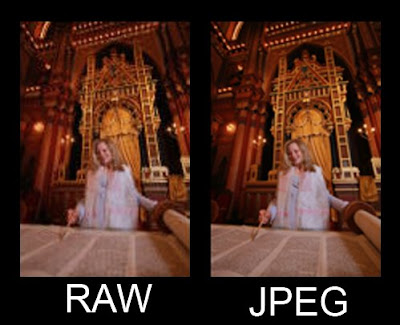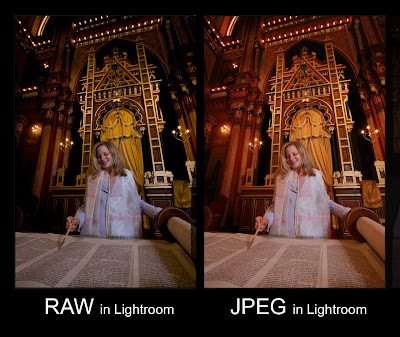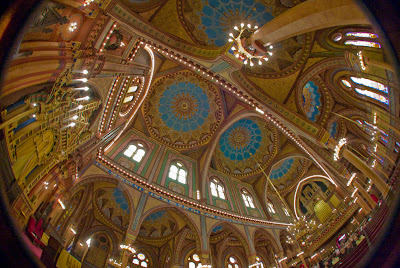I did set the Canon's to shoot RAW with large JPEG. You know I just wanted to see what the fuss was all about with RAW. But this is where it gets very interesting. I loaded them into Lightroom and was giving them a peek yesterday and was surprised (shocked) by what I saw. Take a look at the two images below. This is how they looked in my favorite image viewing program, Irfanview. They both looked the same - as I would expect.
 Now look at the same images after importing into Lightroom. No adjustment of any kind had been made to either image, yet the RAW image is substantially cooler and darker.
Now look at the same images after importing into Lightroom. No adjustment of any kind had been made to either image, yet the RAW image is substantially cooler and darker.  I got the same result in each case of my RAW-JPEG combo shots. Why has Lightroom made the change? I also got the same result in Camera Raw - the RAW image was substantially different in color balance from the Jpeg yet camera settings obviously were the same in both shots. Like I said, "I Don't Think I'm Dumb, Maybe I'm Just Stupid!!"
I got the same result in each case of my RAW-JPEG combo shots. Why has Lightroom made the change? I also got the same result in Camera Raw - the RAW image was substantially different in color balance from the Jpeg yet camera settings obviously were the same in both shots. Like I said, "I Don't Think I'm Dumb, Maybe I'm Just Stupid!!"Now, dear readers, on another note - this is where I may repent and change my life. I started playing around with a few more RAW images in Lightroom and Loved! the results I was getting. I could easily save the highlights, recover the shadows, and pop the vibrance. Check out my fisheye image of the temple ceiling from Saturday morning - pretty cool.
 I have to say, the extremely positive experience gave me cause to consider shooting my next gig completely in RAW - all 4000 shots! (Did I really type that?) Boy, if I switch to RAW, I'll have to give up all my Jpeg jokes. Anyway, I'll keep you posted as I walk through that valley of Raw ;~)
I have to say, the extremely positive experience gave me cause to consider shooting my next gig completely in RAW - all 4000 shots! (Did I really type that?) Boy, if I switch to RAW, I'll have to give up all my Jpeg jokes. Anyway, I'll keep you posted as I walk through that valley of Raw ;~)
My attitude toward raw is: why not? storage is cheap, and if shooting raw will help in that one case out of 100 where that critical shot is just a *tad* too blown out or the wite balance is just too much to be recovered in .jpg it is worth it.
ReplyDeletePlus with tools like lightroom and aperture, the workflow for raw and jpg is identical, so really the only reason I see for using .jpg is the space consideration (and yes, I use .jpg plenty for "snapshots" and whatnot where I know I am not worrying about critical image quality etc...)
Although to be fair, my average shoot is probably around 100-200 shots not 4000, so.... :-)
Every RAW file has an embedded JPEG preview which is used to display on the LCD review after you take the shot. The histograms are based off the JPEG preview as well, I believe. I think IrfanView uses the embedded JPEG preview, instead of displaying the RAW data as it can't actually open the RAW data. Like the Large JPEG you shot, RAW's embedded JPEG is using your camera's built-in settings; saturation, sharpness, stuff like that.
ReplyDeleteLightroom displays the actual RAW data without the in-camera settings. Which would explain the difference. The advantage to RAW is the greater bit-depth information available for editting. Of course, you get things right in the camera, so you might not need the greater editting latitude a newbie like me does. ;-)
I shoot 100% in RAW for the same reason you found. When you shoot in JPG, your camera still takes the picture in RAW format, and then tosses a bunch of data to compress it to JPG. The problem with that is you don't get to choose what gets tossed, your camera does...and me and my camera don't always see eye to eye on that.
ReplyDeleteShooting in RAW means NO compression, and you get to see all the raw data. Eventually all my pictures end up in JPG for viewing and printing, but Photoshop is SO much better at deciding what to toss away in the compression than a camera is.
RAW all the way, baby. :)
I resisted RTAw for a loong time too. Them I swicthed and it was so easy and I would never go back.
ReplyDeleteLike you said there's more to recover. They do process a little diff from JPEG, but they batch really well.
I like knowing that I have all the data in an image I can possible have. It's like my negative as well, and I can always go back to that RAW file.
BWAHAHAHAHAHAHA
ReplyDeleteWelcome to the Darkside! OF all the things you influenced me with at the Master's Class, you did not budge me one pixel on switching from shooting RAW. Can't wait to hear more as you shoot!
I think Craig is correct. IrfanView is only showing you the embedded jpeg image within the RAW file. Once you open this file in lightroom however, it reads the actual data, not the jpeg, and therefore you get your difference. I would expect that if you viewed the 2 images in Adobe Bridge, you would see a difference in the 2 as well (not sure on that though!).
ReplyDeleteAs others have mentioned, IrfanView is showing you either the embedded JPEG preview (which visually should be nearly identical to the sidecar JPEG, just lower quality) or the sidecar JPEG itself.
ReplyDeleteIf you hunt around in the settings you may be able to find a setting to make the viewer look at the RAW file itself, but I'm not sure what could be gained by this as each RAW converter has its own proprietary settings and how they're interpreted, so you can't trust how the viewer will display them. I wouldn't trust a fast viewer to display any image correctly other than an sRGB-profile image in a standard format such as JPEG (even a color-managed viewer).
Adobe Lightroom and Camera Raw share the same underlying RAW code, so as long as you keep their versions in "sync" (usually the release notes for the software comment on this) you should be able to flip back and forth between them, assuming you save the XMP metadata in Lightroom. Switching to another RAW converter (e.g., Photomatix HDR software) would probably ignore most or all the RAW settings.
As a side note, if you haven't, try FastStone Viewer, which is my preferred viewer...it has IMO a more intuitive and faster interface than IrfanView, very similar to what ACDSee used to be many years ago. I'm guessing it probably also just looks at the JPEG, not the RAW data directly, but I haven't really explored this. As I said, if I care how a photo is presented, I'll convert it to sRGB JPEG first.
I'm with Chris Barnes on this one David. Resistance is futile!
ReplyDeleteSteve Hobart
While some of the other posters touched on the what, I think that they may be missing your question of why is there a difference.
ReplyDeleteI would ask you to check how you have your Picture Styles set. If you have them set to anything other than Neutral or Faithful, then your 40D's DIGIC III processor is applying an adjustment to any number of parameters. This isn't just a White Balance issue, as it may appear just by looking at the previews.
While ACR/Lightroom do a really good job, I don't think that they are compatible with proprietary in-camera adjustments like Picture Styles or Dust-Off data.
The test of this would be to run an image through Canon's RAW converter and see what you get. My guess is that it will either automatically apply the Picture Style option set when you took the photo or will give you an option to apply the Picture Style to the RAW conversion.
About the only way to get close to this, if you like the results that Picture Styles is giving you is to set up Develop Presets in Lightroom which will mimic those results. At least then you can have a starting point similar to your JPEG with all of the control benefits of RAW.
Hope this answered your question.
Come on David ... don't you feel a little dirty shooting in RAW ... I mean seriously ;-)
ReplyDeleteThis is indeed a wondrous day! :)
ReplyDeleteI think Alessandro (hey buddy!) is right on the money too.
Hey, I know where you can get some cool Lightroom training if you ever need it too.
Take care.
Matt K
Wow, I had no idea. I too have been shooting mostly jpg, I wonder over every once in a while, but haven't stayed there. You're convincing me to check it out seriously. What a week, this is like finding out Kevin Kubota shoots Nikon. D200 at that and is thinking about making room for the D3. (like me)
ReplyDeleteSearch the net for Camera Calibration in Lightroom to find out how to do so.
ReplyDeleteI'm a little stunned that a photographer with this level of credentials is using the cheesy irfan view to manage his images. Maybe its come some distance since the image view with the road-kill icons...
I think Matt means Scott Kelby ;)
ReplyDeleteSeriously though, the reason for the difference with the RAW in Lightroom, is that Lightroom doesn't read the picture styles. Of course you can get close and create Presets to apply on Import. Also there's been big talk on the V2 Beta forums about Adobe and colour, so fingers crossed on that.
While Camera Calibration is the tool to use, it's not the be all and end all of it. You can use scripts in Camera RAW that automate Bruce Fraser's method for cailbration, but ultimately we don't want accurate colour, we want pleasing colour.
Congrats on taking the firsts steps in RAW. Despite all the negative press on JPEG, some of my best selling images were shot as JPEG's. Still, I love the creative freedom of RAW, along with the odd occasion where it allowed me to salvage from accidental underexposure.
LR (and ACR) both do a basic level of adjustment to raw files on import which you can tune with the Camera Calibration settings, or with a custom develop setting (and develop on import).
ReplyDeleteBy default, you'll get an image from the RAW that is in line with Adobe's take on how it should look (frequently not how you want it to look, but a good starting point).
I shoot raw for the archival quality of it. It's like shooting with film, in that the raw is as close to a negative you're likely to get. It's not a finished product, but all the data you captured is there.
David,
ReplyDeleteI'm a 100% RAW shooter. But, after seeing your latest kelbytraining.com video, I very much respect your jpeg shooting because you are so focused on proper capture which may be more important than anything in a workflow.
I'm a RAW Cheerleader. Raw, Raw, RAW! :-)
ReplyDeleteSeriously. With Lightroom and raw files, 99% of the files I post for clients have never seen Photoshop. The only images that get touched by photoshop are the ones people have paid me to print.
Go raw, you'll never go back.
Here is why I choose to shoot in RAW. If I shoot in JPEG, I allow the primary interpretation of the scene to be that of the camera company's engineering department.
ReplyDeleteWhile we have come a long way with non-destructive editing for JPEG files, some of the creative decisions which I could have made with a RAW file have already been made and either are very difficult to reverse or can't be reversed.
With Lightroom and some practice (or creating presets) you can get the RAW file to the point of the JPEG file fairly quick. I also think that that the little extra effort to do the RAW conversion makes one more selective in what image they determine to be keepers.
Hi David
ReplyDeleteI love a convert, one who has seen the light. Raw Light.
A past student of yours, well actually, I am still a student of yours and enjoy your blog. I hope to make it back to Cincinatti (mispelled I am sure)
Allen Austin from Virginia
This is so funny. I feel so similarly it's as if I wrote it!! I too have been like "RAW SCHMAW" for a long time now, but doing a big commercial job last month and using Lightroom for the first time changed my life. I say 'ditto' to every single thing that you said in your post and was laughing out loud.
ReplyDeleteI am positively addicted to Lightroom now, and use it for 90% of my processing. I only wish I had started sooner! And what it does with RAW photos, even with tiny adjustments, is just fantastic. I am a believer now, as it sounds like you are too! Thanks for sharing with us your 'change of heart'. :-)
I'm with david terry.
ReplyDeleteOnce I started shooting raw, I never considered jpeg again.
Good for you Dave.
Ray